Sexual Harassment in Tourism Workplaces: A Case Study
VerifiedAdded on 2023/04/21
|11
|2446
|131
AI Summary
This paper discusses the issue of sexual harassment in tourism workplaces, focusing on a case study in the hospitality industry of Australia. It explores the prevalence of sexual harassment, risk factors in the tourism sector, the process of conducting an investigation, and recommendations for preventing future incidents.
Contribute Materials
Your contribution can guide someone’s learning journey. Share your
documents today.
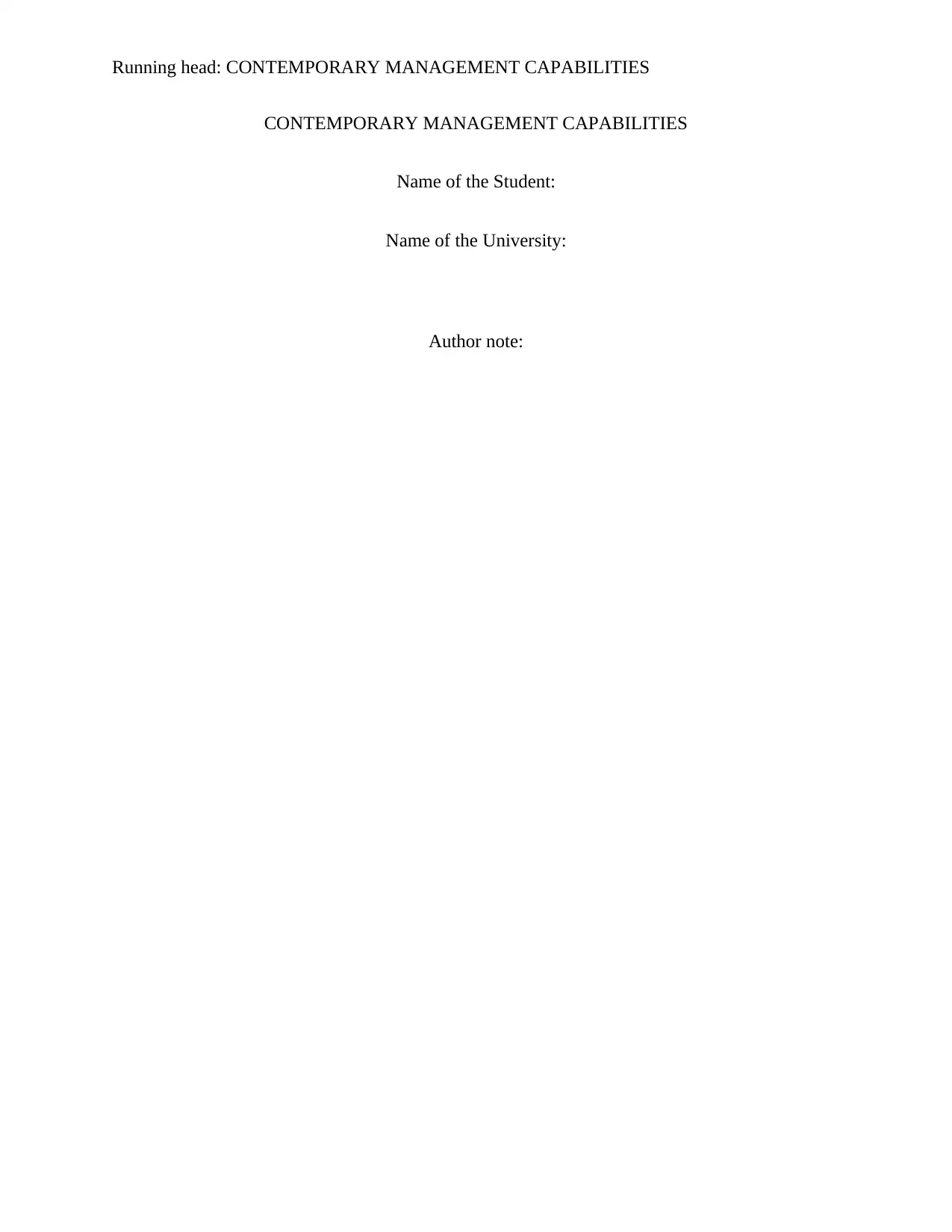
Running head: CONTEMPORARY MANAGEMENT CAPABILITIES
CONTEMPORARY MANAGEMENT CAPABILITIES
Name of the Student:
Name of the University:
Author note:
CONTEMPORARY MANAGEMENT CAPABILITIES
Name of the Student:
Name of the University:
Author note:
Secure Best Marks with AI Grader
Need help grading? Try our AI Grader for instant feedback on your assignments.
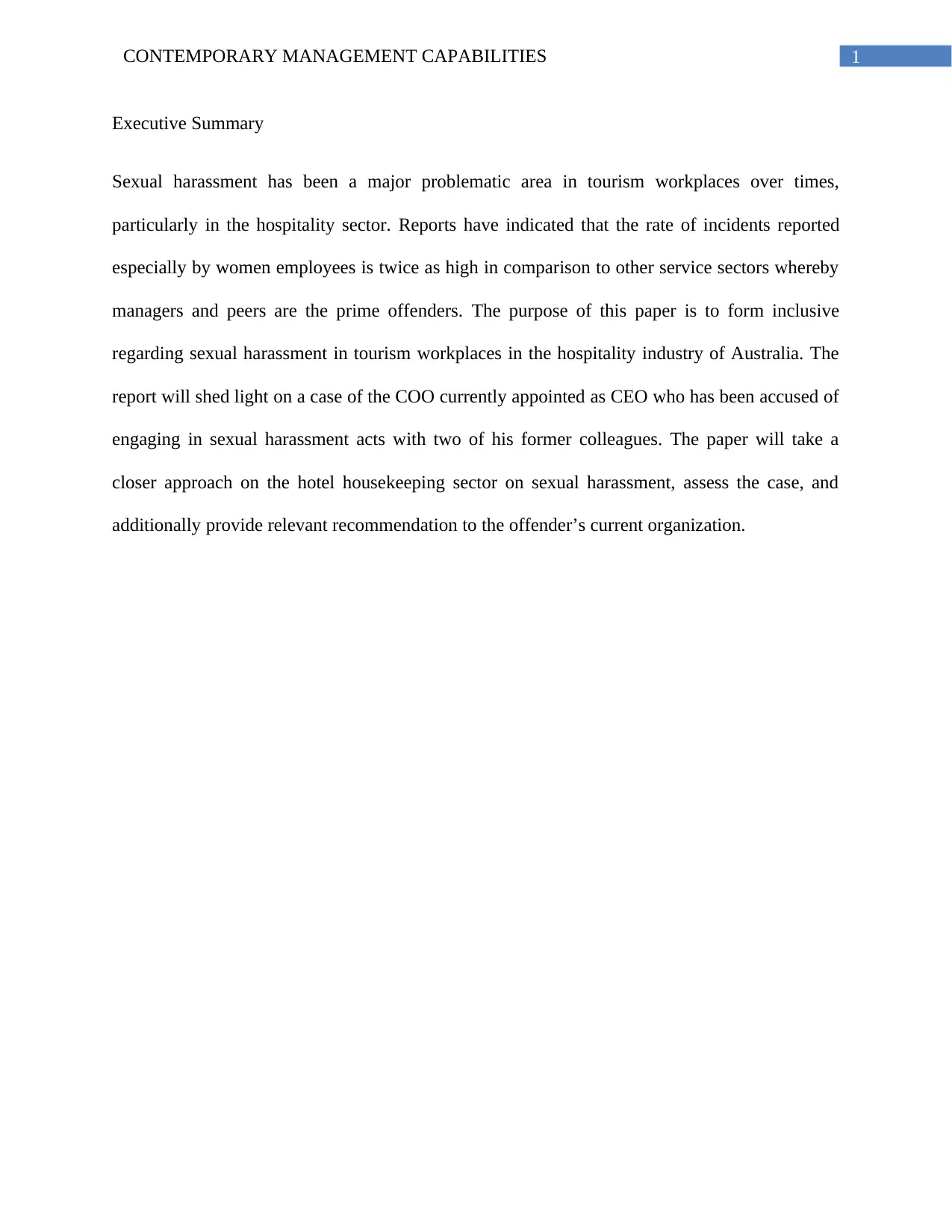
1CONTEMPORARY MANAGEMENT CAPABILITIES
Executive Summary
Sexual harassment has been a major problematic area in tourism workplaces over times,
particularly in the hospitality sector. Reports have indicated that the rate of incidents reported
especially by women employees is twice as high in comparison to other service sectors whereby
managers and peers are the prime offenders. The purpose of this paper is to form inclusive
regarding sexual harassment in tourism workplaces in the hospitality industry of Australia. The
report will shed light on a case of the COO currently appointed as CEO who has been accused of
engaging in sexual harassment acts with two of his former colleagues. The paper will take a
closer approach on the hotel housekeeping sector on sexual harassment, assess the case, and
additionally provide relevant recommendation to the offender’s current organization.
Executive Summary
Sexual harassment has been a major problematic area in tourism workplaces over times,
particularly in the hospitality sector. Reports have indicated that the rate of incidents reported
especially by women employees is twice as high in comparison to other service sectors whereby
managers and peers are the prime offenders. The purpose of this paper is to form inclusive
regarding sexual harassment in tourism workplaces in the hospitality industry of Australia. The
report will shed light on a case of the COO currently appointed as CEO who has been accused of
engaging in sexual harassment acts with two of his former colleagues. The paper will take a
closer approach on the hotel housekeeping sector on sexual harassment, assess the case, and
additionally provide relevant recommendation to the offender’s current organization.
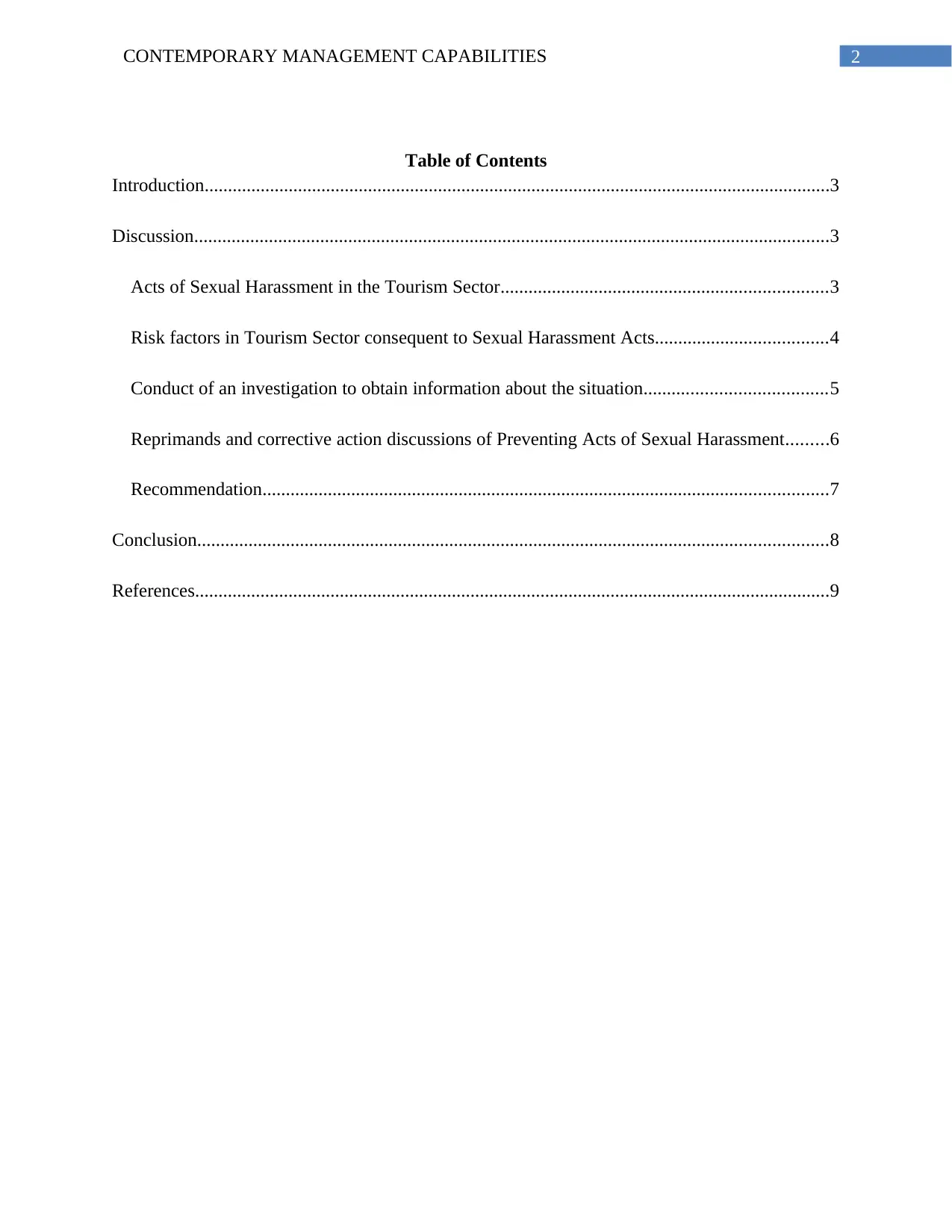
2CONTEMPORARY MANAGEMENT CAPABILITIES
Table of Contents
Introduction......................................................................................................................................3
Discussion........................................................................................................................................3
Acts of Sexual Harassment in the Tourism Sector......................................................................3
Risk factors in Tourism Sector consequent to Sexual Harassment Acts.....................................4
Conduct of an investigation to obtain information about the situation.......................................5
Reprimands and corrective action discussions of Preventing Acts of Sexual Harassment.........6
Recommendation.........................................................................................................................7
Conclusion.......................................................................................................................................8
References........................................................................................................................................9
Table of Contents
Introduction......................................................................................................................................3
Discussion........................................................................................................................................3
Acts of Sexual Harassment in the Tourism Sector......................................................................3
Risk factors in Tourism Sector consequent to Sexual Harassment Acts.....................................4
Conduct of an investigation to obtain information about the situation.......................................5
Reprimands and corrective action discussions of Preventing Acts of Sexual Harassment.........6
Recommendation.........................................................................................................................7
Conclusion.......................................................................................................................................8
References........................................................................................................................................9
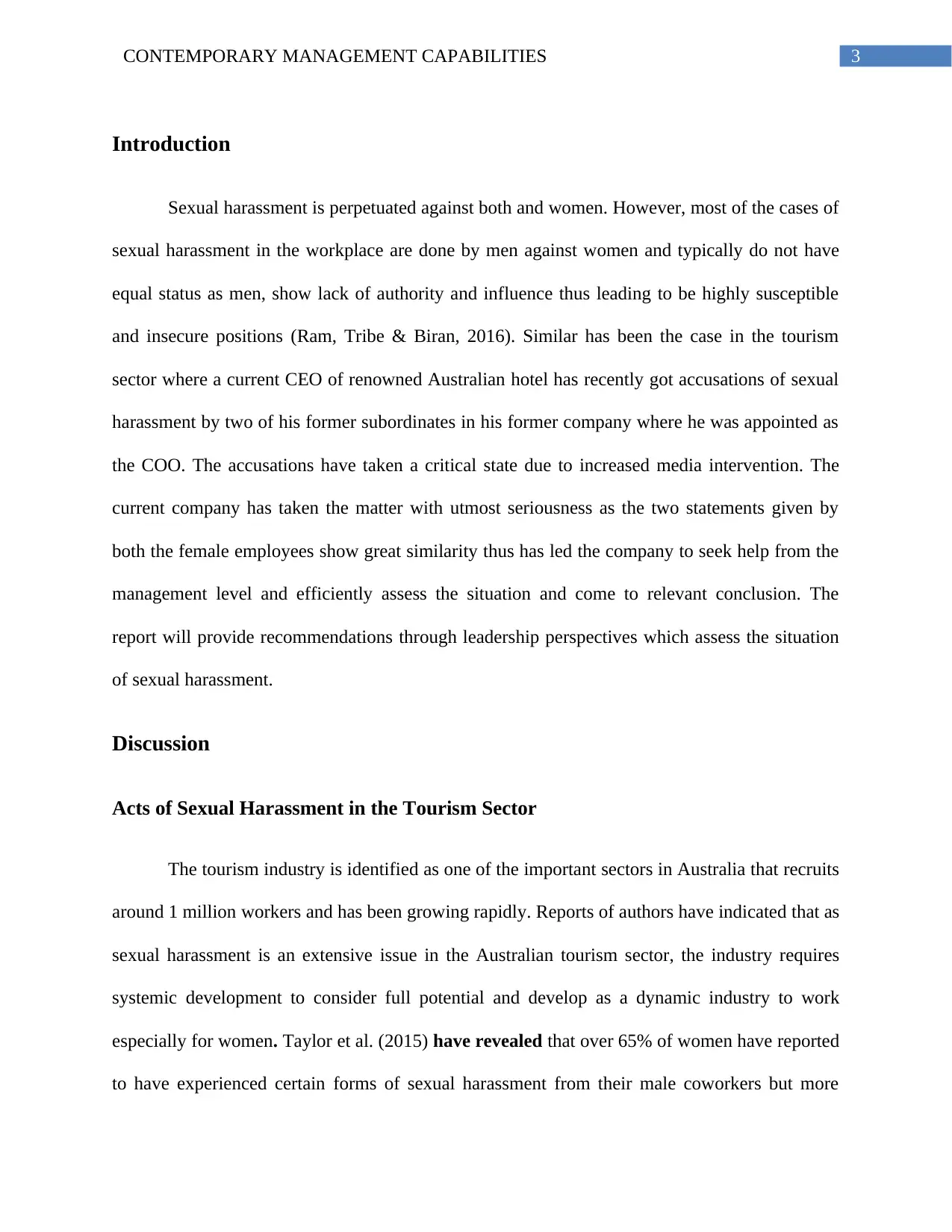
3CONTEMPORARY MANAGEMENT CAPABILITIES
Introduction
Sexual harassment is perpetuated against both and women. However, most of the cases of
sexual harassment in the workplace are done by men against women and typically do not have
equal status as men, show lack of authority and influence thus leading to be highly susceptible
and insecure positions (Ram, Tribe & Biran, 2016). Similar has been the case in the tourism
sector where a current CEO of renowned Australian hotel has recently got accusations of sexual
harassment by two of his former subordinates in his former company where he was appointed as
the COO. The accusations have taken a critical state due to increased media intervention. The
current company has taken the matter with utmost seriousness as the two statements given by
both the female employees show great similarity thus has led the company to seek help from the
management level and efficiently assess the situation and come to relevant conclusion. The
report will provide recommendations through leadership perspectives which assess the situation
of sexual harassment.
Discussion
Acts of Sexual Harassment in the Tourism Sector
The tourism industry is identified as one of the important sectors in Australia that recruits
around 1 million workers and has been growing rapidly. Reports of authors have indicated that as
sexual harassment is an extensive issue in the Australian tourism sector, the industry requires
systemic development to consider full potential and develop as a dynamic industry to work
especially for women. Taylor et al. (2015) have revealed that over 65% of women have reported
to have experienced certain forms of sexual harassment from their male coworkers but more
Introduction
Sexual harassment is perpetuated against both and women. However, most of the cases of
sexual harassment in the workplace are done by men against women and typically do not have
equal status as men, show lack of authority and influence thus leading to be highly susceptible
and insecure positions (Ram, Tribe & Biran, 2016). Similar has been the case in the tourism
sector where a current CEO of renowned Australian hotel has recently got accusations of sexual
harassment by two of his former subordinates in his former company where he was appointed as
the COO. The accusations have taken a critical state due to increased media intervention. The
current company has taken the matter with utmost seriousness as the two statements given by
both the female employees show great similarity thus has led the company to seek help from the
management level and efficiently assess the situation and come to relevant conclusion. The
report will provide recommendations through leadership perspectives which assess the situation
of sexual harassment.
Discussion
Acts of Sexual Harassment in the Tourism Sector
The tourism industry is identified as one of the important sectors in Australia that recruits
around 1 million workers and has been growing rapidly. Reports of authors have indicated that as
sexual harassment is an extensive issue in the Australian tourism sector, the industry requires
systemic development to consider full potential and develop as a dynamic industry to work
especially for women. Taylor et al. (2015) have revealed that over 65% of women have reported
to have experienced certain forms of sexual harassment from their male coworkers but more
Secure Best Marks with AI Grader
Need help grading? Try our AI Grader for instant feedback on your assignments.
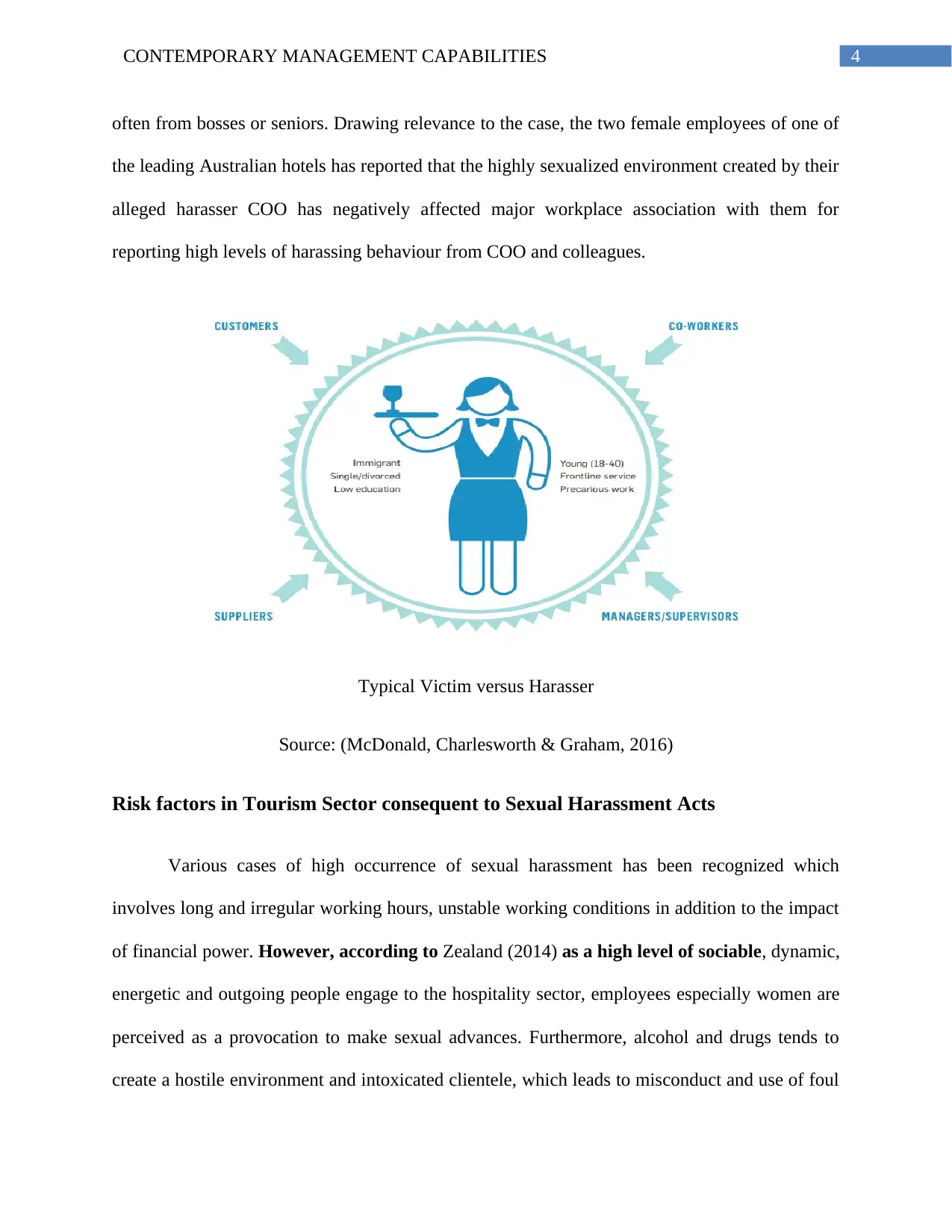
4CONTEMPORARY MANAGEMENT CAPABILITIES
often from bosses or seniors. Drawing relevance to the case, the two female employees of one of
the leading Australian hotels has reported that the highly sexualized environment created by their
alleged harasser COO has negatively affected major workplace association with them for
reporting high levels of harassing behaviour from COO and colleagues.
Typical Victim versus Harasser
Source: (McDonald, Charlesworth & Graham, 2016)
Risk factors in Tourism Sector consequent to Sexual Harassment Acts
Various cases of high occurrence of sexual harassment has been recognized which
involves long and irregular working hours, unstable working conditions in addition to the impact
of financial power. However, according to Zealand (2014) as a high level of sociable, dynamic,
energetic and outgoing people engage to the hospitality sector, employees especially women are
perceived as a provocation to make sexual advances. Furthermore, alcohol and drugs tends to
create a hostile environment and intoxicated clientele, which leads to misconduct and use of foul
often from bosses or seniors. Drawing relevance to the case, the two female employees of one of
the leading Australian hotels has reported that the highly sexualized environment created by their
alleged harasser COO has negatively affected major workplace association with them for
reporting high levels of harassing behaviour from COO and colleagues.
Typical Victim versus Harasser
Source: (McDonald, Charlesworth & Graham, 2016)
Risk factors in Tourism Sector consequent to Sexual Harassment Acts
Various cases of high occurrence of sexual harassment has been recognized which
involves long and irregular working hours, unstable working conditions in addition to the impact
of financial power. However, according to Zealand (2014) as a high level of sociable, dynamic,
energetic and outgoing people engage to the hospitality sector, employees especially women are
perceived as a provocation to make sexual advances. Furthermore, alcohol and drugs tends to
create a hostile environment and intoxicated clientele, which leads to misconduct and use of foul

5CONTEMPORARY MANAGEMENT CAPABILITIES
language. In the given case study, the two female employees have given emphasis to these
factors which have been consequential to the sexual harassment act experienced. These
statements have led to the obligation to investigate reports of harassment.
Conduct of an investigation to obtain information about the situation
The concept of an investigation typically can be perceived as extensive, complex and
even intimidating procedure. However, in this context, the investigation is related to the
exploration of events which have actually happened. Taylor et al. (2015) have noted that
effective evaluation of critical cases related to sexual harassment requires managers of the
company to procure the support services available at the department. The management
department investigating this particular case of the CEO has enlisted the help of experts of
Occupational Health Service such as welfare officer or psychologist who have been appointed to
make observations among other critical factors. Reports of sexual harassment have been
documented and registered in order to protect the affected parties (Ram, Tribe & Biran, 2016).
At this stage, the HR manager has the option to apply a confidentiality procedure while
registering documents. The case has been shown only to the managers of CEO’s present
company and further consulted to direct registrar. Comprehensive studies of Benjamin et al.
(2016) have noted that continuous documentation of the enquiry along with the measures
implemented is likely to create an important foundation for the proceedings of the effects of the
measures. For example, considering the case study, management has proficiently presented
comprehensive documentation as to what type of preventive measures against such acts have
been taken within the organization. Additionally, while assessing the case, management has
witnessed a sudden implementation of special measures in the CEO’s previous company after the
reported date of the alleged act of sexual harassment. However, certain discrepancies of CEO’s
language. In the given case study, the two female employees have given emphasis to these
factors which have been consequential to the sexual harassment act experienced. These
statements have led to the obligation to investigate reports of harassment.
Conduct of an investigation to obtain information about the situation
The concept of an investigation typically can be perceived as extensive, complex and
even intimidating procedure. However, in this context, the investigation is related to the
exploration of events which have actually happened. Taylor et al. (2015) have noted that
effective evaluation of critical cases related to sexual harassment requires managers of the
company to procure the support services available at the department. The management
department investigating this particular case of the CEO has enlisted the help of experts of
Occupational Health Service such as welfare officer or psychologist who have been appointed to
make observations among other critical factors. Reports of sexual harassment have been
documented and registered in order to protect the affected parties (Ram, Tribe & Biran, 2016).
At this stage, the HR manager has the option to apply a confidentiality procedure while
registering documents. The case has been shown only to the managers of CEO’s present
company and further consulted to direct registrar. Comprehensive studies of Benjamin et al.
(2016) have noted that continuous documentation of the enquiry along with the measures
implemented is likely to create an important foundation for the proceedings of the effects of the
measures. For example, considering the case study, management has proficiently presented
comprehensive documentation as to what type of preventive measures against such acts have
been taken within the organization. Additionally, while assessing the case, management has
witnessed a sudden implementation of special measures in the CEO’s previous company after the
reported date of the alleged act of sexual harassment. However, certain discrepancies of CEO’s
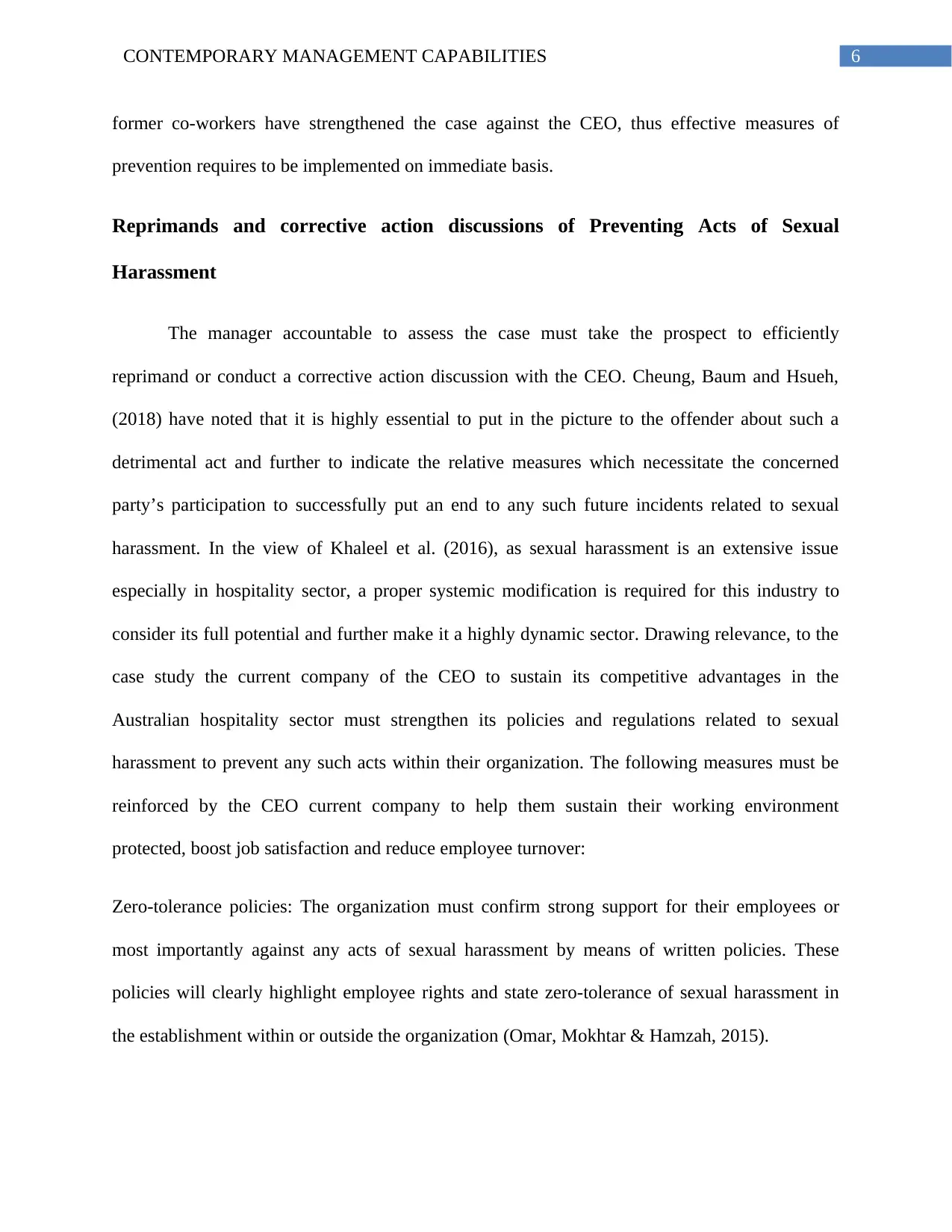
6CONTEMPORARY MANAGEMENT CAPABILITIES
former co-workers have strengthened the case against the CEO, thus effective measures of
prevention requires to be implemented on immediate basis.
Reprimands and corrective action discussions of Preventing Acts of Sexual
Harassment
The manager accountable to assess the case must take the prospect to efficiently
reprimand or conduct a corrective action discussion with the CEO. Cheung, Baum and Hsueh,
(2018) have noted that it is highly essential to put in the picture to the offender about such a
detrimental act and further to indicate the relative measures which necessitate the concerned
party’s participation to successfully put an end to any such future incidents related to sexual
harassment. In the view of Khaleel et al. (2016), as sexual harassment is an extensive issue
especially in hospitality sector, a proper systemic modification is required for this industry to
consider its full potential and further make it a highly dynamic sector. Drawing relevance, to the
case study the current company of the CEO to sustain its competitive advantages in the
Australian hospitality sector must strengthen its policies and regulations related to sexual
harassment to prevent any such acts within their organization. The following measures must be
reinforced by the CEO current company to help them sustain their working environment
protected, boost job satisfaction and reduce employee turnover:
Zero-tolerance policies: The organization must confirm strong support for their employees or
most importantly against any acts of sexual harassment by means of written policies. These
policies will clearly highlight employee rights and state zero-tolerance of sexual harassment in
the establishment within or outside the organization (Omar, Mokhtar & Hamzah, 2015).
former co-workers have strengthened the case against the CEO, thus effective measures of
prevention requires to be implemented on immediate basis.
Reprimands and corrective action discussions of Preventing Acts of Sexual
Harassment
The manager accountable to assess the case must take the prospect to efficiently
reprimand or conduct a corrective action discussion with the CEO. Cheung, Baum and Hsueh,
(2018) have noted that it is highly essential to put in the picture to the offender about such a
detrimental act and further to indicate the relative measures which necessitate the concerned
party’s participation to successfully put an end to any such future incidents related to sexual
harassment. In the view of Khaleel et al. (2016), as sexual harassment is an extensive issue
especially in hospitality sector, a proper systemic modification is required for this industry to
consider its full potential and further make it a highly dynamic sector. Drawing relevance, to the
case study the current company of the CEO to sustain its competitive advantages in the
Australian hospitality sector must strengthen its policies and regulations related to sexual
harassment to prevent any such acts within their organization. The following measures must be
reinforced by the CEO current company to help them sustain their working environment
protected, boost job satisfaction and reduce employee turnover:
Zero-tolerance policies: The organization must confirm strong support for their employees or
most importantly against any acts of sexual harassment by means of written policies. These
policies will clearly highlight employee rights and state zero-tolerance of sexual harassment in
the establishment within or outside the organization (Omar, Mokhtar & Hamzah, 2015).
Paraphrase This Document
Need a fresh take? Get an instant paraphrase of this document with our AI Paraphraser
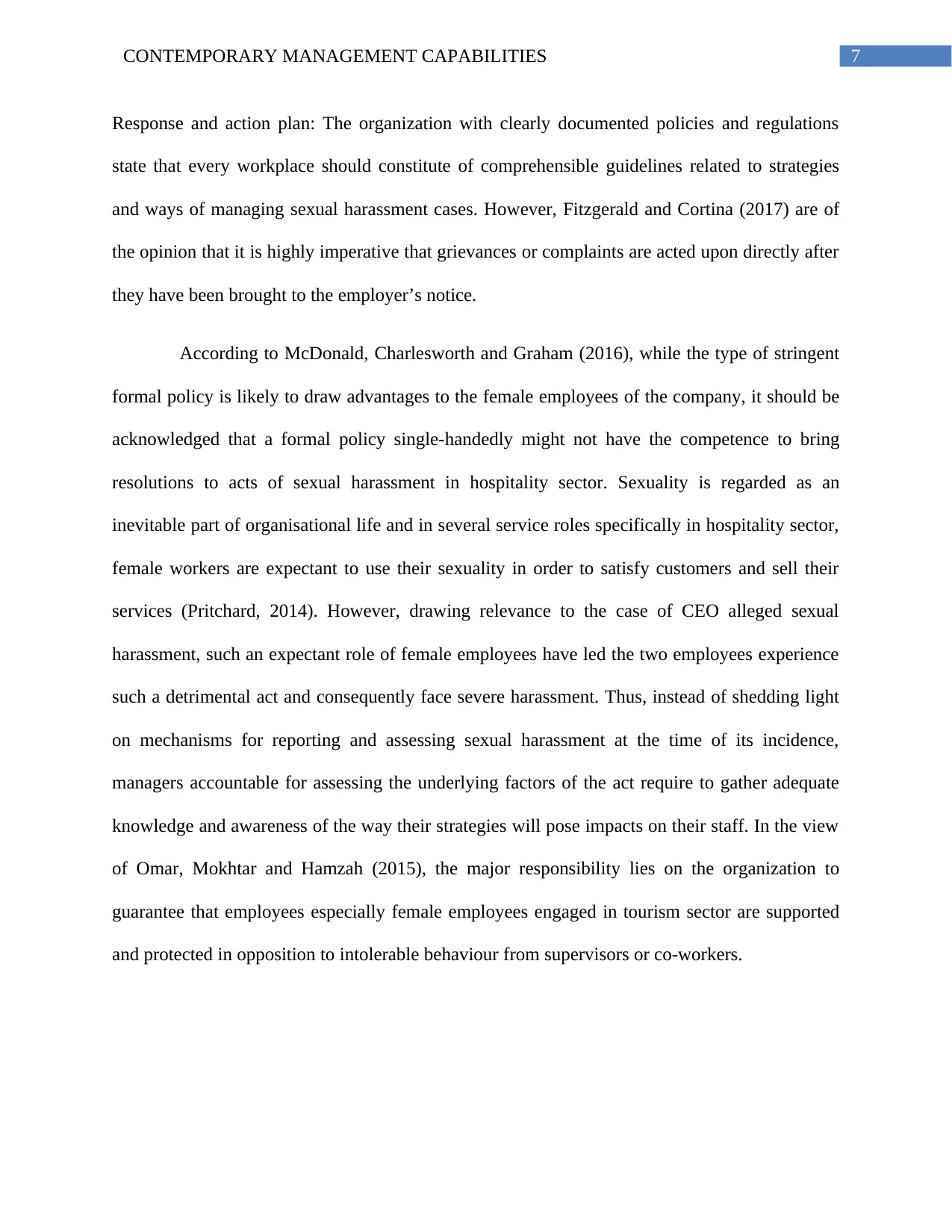
7CONTEMPORARY MANAGEMENT CAPABILITIES
Response and action plan: The organization with clearly documented policies and regulations
state that every workplace should constitute of comprehensible guidelines related to strategies
and ways of managing sexual harassment cases. However, Fitzgerald and Cortina (2017) are of
the opinion that it is highly imperative that grievances or complaints are acted upon directly after
they have been brought to the employer’s notice.
According to McDonald, Charlesworth and Graham (2016), while the type of stringent
formal policy is likely to draw advantages to the female employees of the company, it should be
acknowledged that a formal policy single-handedly might not have the competence to bring
resolutions to acts of sexual harassment in hospitality sector. Sexuality is regarded as an
inevitable part of organisational life and in several service roles specifically in hospitality sector,
female workers are expectant to use their sexuality in order to satisfy customers and sell their
services (Pritchard, 2014). However, drawing relevance to the case of CEO alleged sexual
harassment, such an expectant role of female employees have led the two employees experience
such a detrimental act and consequently face severe harassment. Thus, instead of shedding light
on mechanisms for reporting and assessing sexual harassment at the time of its incidence,
managers accountable for assessing the underlying factors of the act require to gather adequate
knowledge and awareness of the way their strategies will pose impacts on their staff. In the view
of Omar, Mokhtar and Hamzah (2015), the major responsibility lies on the organization to
guarantee that employees especially female employees engaged in tourism sector are supported
and protected in opposition to intolerable behaviour from supervisors or co-workers.
Response and action plan: The organization with clearly documented policies and regulations
state that every workplace should constitute of comprehensible guidelines related to strategies
and ways of managing sexual harassment cases. However, Fitzgerald and Cortina (2017) are of
the opinion that it is highly imperative that grievances or complaints are acted upon directly after
they have been brought to the employer’s notice.
According to McDonald, Charlesworth and Graham (2016), while the type of stringent
formal policy is likely to draw advantages to the female employees of the company, it should be
acknowledged that a formal policy single-handedly might not have the competence to bring
resolutions to acts of sexual harassment in hospitality sector. Sexuality is regarded as an
inevitable part of organisational life and in several service roles specifically in hospitality sector,
female workers are expectant to use their sexuality in order to satisfy customers and sell their
services (Pritchard, 2014). However, drawing relevance to the case of CEO alleged sexual
harassment, such an expectant role of female employees have led the two employees experience
such a detrimental act and consequently face severe harassment. Thus, instead of shedding light
on mechanisms for reporting and assessing sexual harassment at the time of its incidence,
managers accountable for assessing the underlying factors of the act require to gather adequate
knowledge and awareness of the way their strategies will pose impacts on their staff. In the view
of Omar, Mokhtar and Hamzah (2015), the major responsibility lies on the organization to
guarantee that employees especially female employees engaged in tourism sector are supported
and protected in opposition to intolerable behaviour from supervisors or co-workers.

8CONTEMPORARY MANAGEMENT CAPABILITIES
Recommendation
Constructive dismissal of the offender can be considered as an effective recommendation
not only of an employer’s acts but also of an employer who in action or exclusion. It is important
to note that the lack of an effective sexual harassment policy at the workplace or an employer’s
acts in relation to sexual harassment of employees by fellow employees or even clients are likely
to provide sustained employment intolerable situation for the employee (Poulston, 2015). The
resignation of an employee in such a situation is regarded as a highly effective recommendation.
Furthermore, management need to validate their assurance towards ethical practices and must be
prepared appropriately in terms of awareness in order to proficiently handle human behavioural
problems especially acts of sexual harassment issues which are likely to be noticeable in the
workplace. Moreover, the prohibition of any form of sexual harassment must be evidently
evident in organizational policy and must further be implemented to the actions of all employees,
customers at all levels. Additionally, the policy, which is functioning, must be restated in
artworks such as posters and likewise in the organizational code of conduct as well as in all the
services of the organization.
Conclusion
Therefore, from the above discussion, it can be concluded since the dismissal is based on
acts of sexual harassment, the dismissal would be automatically equitable. Furthermore, to
prevent accountability for unjust dismissals, which involves directly unjust dismissals employers
would be well recommended to take methods to position effective sexual harassment policies in
proper place in order to safeguard employees against sexual harassment.
Recommendation
Constructive dismissal of the offender can be considered as an effective recommendation
not only of an employer’s acts but also of an employer who in action or exclusion. It is important
to note that the lack of an effective sexual harassment policy at the workplace or an employer’s
acts in relation to sexual harassment of employees by fellow employees or even clients are likely
to provide sustained employment intolerable situation for the employee (Poulston, 2015). The
resignation of an employee in such a situation is regarded as a highly effective recommendation.
Furthermore, management need to validate their assurance towards ethical practices and must be
prepared appropriately in terms of awareness in order to proficiently handle human behavioural
problems especially acts of sexual harassment issues which are likely to be noticeable in the
workplace. Moreover, the prohibition of any form of sexual harassment must be evidently
evident in organizational policy and must further be implemented to the actions of all employees,
customers at all levels. Additionally, the policy, which is functioning, must be restated in
artworks such as posters and likewise in the organizational code of conduct as well as in all the
services of the organization.
Conclusion
Therefore, from the above discussion, it can be concluded since the dismissal is based on
acts of sexual harassment, the dismissal would be automatically equitable. Furthermore, to
prevent accountability for unjust dismissals, which involves directly unjust dismissals employers
would be well recommended to take methods to position effective sexual harassment policies in
proper place in order to safeguard employees against sexual harassment.
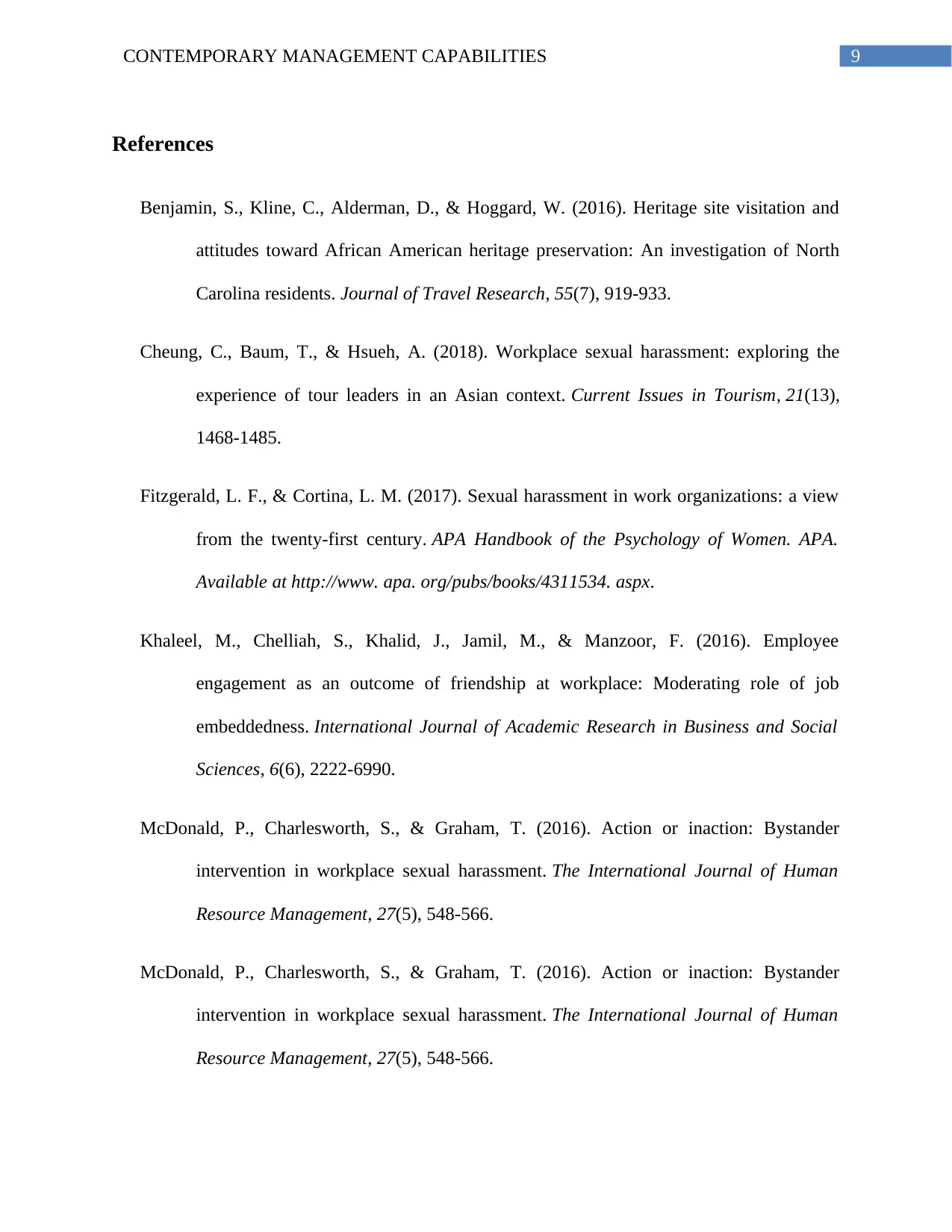
9CONTEMPORARY MANAGEMENT CAPABILITIES
References
Benjamin, S., Kline, C., Alderman, D., & Hoggard, W. (2016). Heritage site visitation and
attitudes toward African American heritage preservation: An investigation of North
Carolina residents. Journal of Travel Research, 55(7), 919-933.
Cheung, C., Baum, T., & Hsueh, A. (2018). Workplace sexual harassment: exploring the
experience of tour leaders in an Asian context. Current Issues in Tourism, 21(13),
1468-1485.
Fitzgerald, L. F., & Cortina, L. M. (2017). Sexual harassment in work organizations: a view
from the twenty-first century. APA Handbook of the Psychology of Women. APA.
Available at http://www. apa. org/pubs/books/4311534. aspx.
Khaleel, M., Chelliah, S., Khalid, J., Jamil, M., & Manzoor, F. (2016). Employee
engagement as an outcome of friendship at workplace: Moderating role of job
embeddedness. International Journal of Academic Research in Business and Social
Sciences, 6(6), 2222-6990.
McDonald, P., Charlesworth, S., & Graham, T. (2016). Action or inaction: Bystander
intervention in workplace sexual harassment. The International Journal of Human
Resource Management, 27(5), 548-566.
McDonald, P., Charlesworth, S., & Graham, T. (2016). Action or inaction: Bystander
intervention in workplace sexual harassment. The International Journal of Human
Resource Management, 27(5), 548-566.
References
Benjamin, S., Kline, C., Alderman, D., & Hoggard, W. (2016). Heritage site visitation and
attitudes toward African American heritage preservation: An investigation of North
Carolina residents. Journal of Travel Research, 55(7), 919-933.
Cheung, C., Baum, T., & Hsueh, A. (2018). Workplace sexual harassment: exploring the
experience of tour leaders in an Asian context. Current Issues in Tourism, 21(13),
1468-1485.
Fitzgerald, L. F., & Cortina, L. M. (2017). Sexual harassment in work organizations: a view
from the twenty-first century. APA Handbook of the Psychology of Women. APA.
Available at http://www. apa. org/pubs/books/4311534. aspx.
Khaleel, M., Chelliah, S., Khalid, J., Jamil, M., & Manzoor, F. (2016). Employee
engagement as an outcome of friendship at workplace: Moderating role of job
embeddedness. International Journal of Academic Research in Business and Social
Sciences, 6(6), 2222-6990.
McDonald, P., Charlesworth, S., & Graham, T. (2016). Action or inaction: Bystander
intervention in workplace sexual harassment. The International Journal of Human
Resource Management, 27(5), 548-566.
McDonald, P., Charlesworth, S., & Graham, T. (2016). Action or inaction: Bystander
intervention in workplace sexual harassment. The International Journal of Human
Resource Management, 27(5), 548-566.
Secure Best Marks with AI Grader
Need help grading? Try our AI Grader for instant feedback on your assignments.
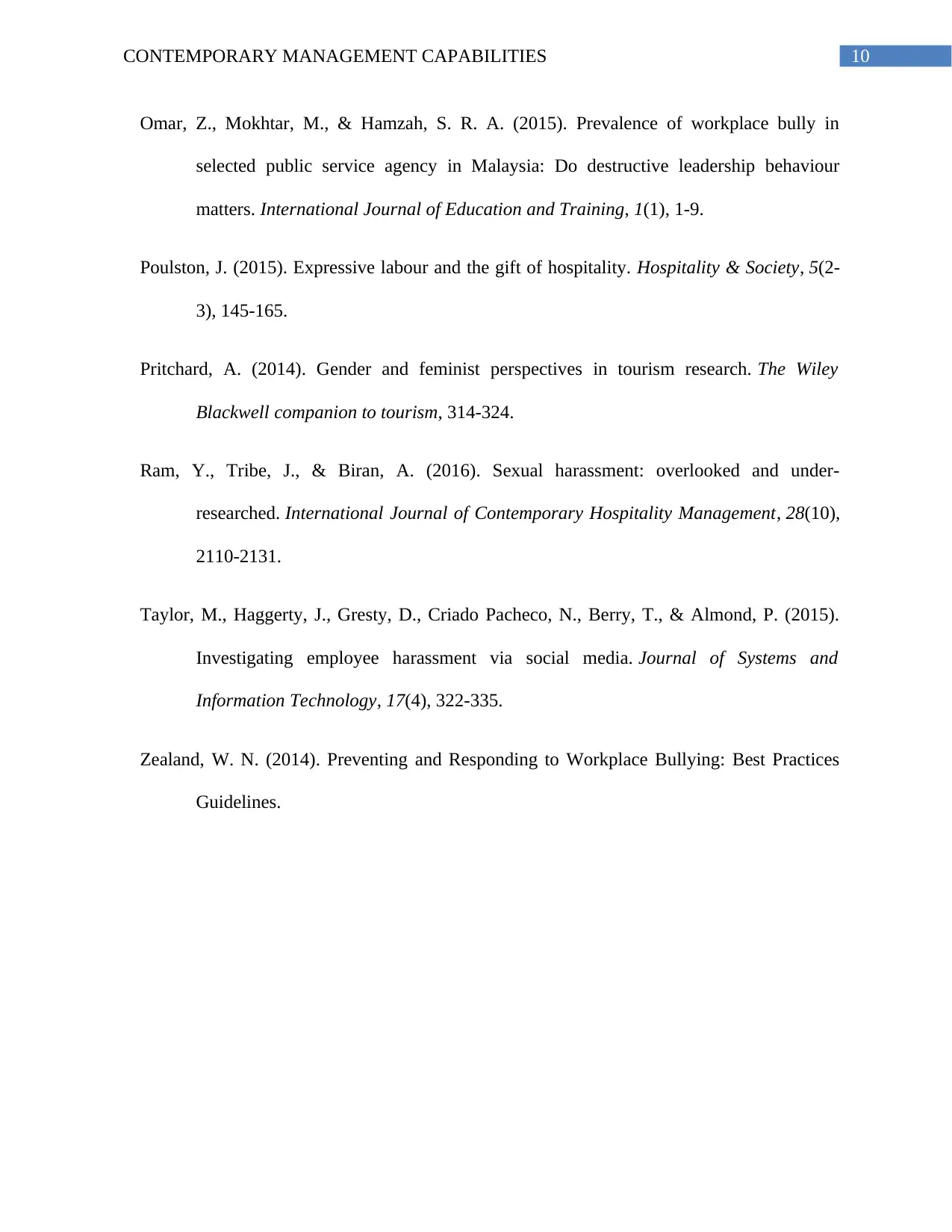
10CONTEMPORARY MANAGEMENT CAPABILITIES
Omar, Z., Mokhtar, M., & Hamzah, S. R. A. (2015). Prevalence of workplace bully in
selected public service agency in Malaysia: Do destructive leadership behaviour
matters. International Journal of Education and Training, 1(1), 1-9.
Poulston, J. (2015). Expressive labour and the gift of hospitality. Hospitality & Society, 5(2-
3), 145-165.
Pritchard, A. (2014). Gender and feminist perspectives in tourism research. The Wiley
Blackwell companion to tourism, 314-324.
Ram, Y., Tribe, J., & Biran, A. (2016). Sexual harassment: overlooked and under-
researched. International Journal of Contemporary Hospitality Management, 28(10),
2110-2131.
Taylor, M., Haggerty, J., Gresty, D., Criado Pacheco, N., Berry, T., & Almond, P. (2015).
Investigating employee harassment via social media. Journal of Systems and
Information Technology, 17(4), 322-335.
Zealand, W. N. (2014). Preventing and Responding to Workplace Bullying: Best Practices
Guidelines.
Omar, Z., Mokhtar, M., & Hamzah, S. R. A. (2015). Prevalence of workplace bully in
selected public service agency in Malaysia: Do destructive leadership behaviour
matters. International Journal of Education and Training, 1(1), 1-9.
Poulston, J. (2015). Expressive labour and the gift of hospitality. Hospitality & Society, 5(2-
3), 145-165.
Pritchard, A. (2014). Gender and feminist perspectives in tourism research. The Wiley
Blackwell companion to tourism, 314-324.
Ram, Y., Tribe, J., & Biran, A. (2016). Sexual harassment: overlooked and under-
researched. International Journal of Contemporary Hospitality Management, 28(10),
2110-2131.
Taylor, M., Haggerty, J., Gresty, D., Criado Pacheco, N., Berry, T., & Almond, P. (2015).
Investigating employee harassment via social media. Journal of Systems and
Information Technology, 17(4), 322-335.
Zealand, W. N. (2014). Preventing and Responding to Workplace Bullying: Best Practices
Guidelines.
1 out of 11
Related Documents
Your All-in-One AI-Powered Toolkit for Academic Success.
+13062052269
info@desklib.com
Available 24*7 on WhatsApp / Email
![[object Object]](/_next/static/media/star-bottom.7253800d.svg)
Unlock your academic potential
© 2024 | Zucol Services PVT LTD | All rights reserved.





